Catholic Church
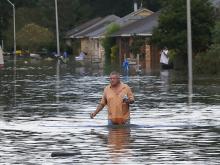
No matter where we are, the climate crisis is not far from home.
For some time it has largely been the world’s most vulnerable, in the global south, bearing the brunt of suffering and climate-induced devastation. Those who have the power to change things have so far all but ignored “the cry of the poor and the cry of the earth,” as Pope Francis wrote in his encyclical a little over a year ago.
But just this past month in the United States — one of the world’s wealthiest nations — we have seen historic droughts, unprecedented floods in Louisiana, and wildfires in California, killing many and displacing tens of thousands.

Pope Francis expressed his “heartfelt sorrow” after a powerful earthquake killed at least 120 people and left a trail of destruction across central Italy. Hundreds of people were injured and dozens of others missing in several small towns after the magnitude-6.2 quake struck at 3:36 a.m. local time (Aug. 24). The quake’s epicenter was about 90 miles northeast of Rome, but the shock waves were felt from the southern city of Naples to the northern town of Rimini on the Adriatic Coast. A powerful aftershock of 5.4 magnitude followed an hour later.

Ever since Pope Francis was elected in March 2013, he has faced strong opposition from traditionalists unhappy with his push for church reforms — and the face of that opposition has often been Cardinal Raymond Burke, an American prelate who has worked in senior positions in Rome for most of the past decade.

Nearly 500 years after Martin Luther nailed his 95 theses to the Castle Church door, the largest Lutheran denomination in the U.S. has approved a declaration recognizing “there are no longer church-dividing issues” on many points with the Roman Catholic Church.

The Vatican this week unveiled Pope Francis’ picks for a 12-member panel of scholars who will study the question of whether women were ordained as deacons in the early church, and whether they could be ordained in the Catholic Church today — a historic step, if it were to happen.
What will the commission, which will operate under the supervision of an archbishop from the Vatican’s doctrinal office, do?
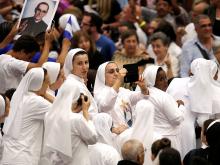
The Vatican has confirmed that “after intense prayer and mature reflection, Pope Francis has decided to institute the Commission for the Study of the Diaconate of Women.” A deacon is a minister of the Catholic Church who is ordained as a sacramental sign of Christ, who came “to serve and not to be served.”
If women are permitted to be deacons by the church, they can baptize as well as marry and bury. They can offer homilies. These are momentous steps.

Carl Anderson, leader of the Knights of Columbus fraternal order and one of the most influential lay Catholics in the church, has said that abortion outweighs all other issues in the presidential campaign and Catholics cannot vote for a candidate who supports abortion rights.
Abortion is not “just another political issue” but “is in reality a legal regime that has resulted in more than 40 million deaths,” Anderson told the Knights’ international convention in Toronto in a speech on Aug. 2.
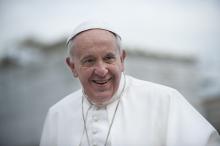
During a meeting with hundreds of nuns back in May, Pope Francis surprised many both in and outside the Catholic Church by saying he’d like to consider the historical role of female deacons, or deaconesses, in the early church and whether the diaconate should be re-opened to women.
On Aug. 1, Pope Francis made good on his expressed interest by appointing a commission to study the question, reports CNN.
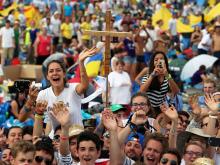
To outsiders, a massive rally of young Catholics waving flags and chanting “Francis” might seem like a strange spectacle far removed from today’s pressing concerns.
But in a world scarred by religiously-inspired violence and grappling with a global migrants crisis, the World Youth Day gathering in Poland that wrapped up on July 31 could be read as a powerful piece of counterprogramming.
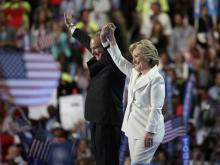
If there is one constant in this unconventional presidential campaign it is the unpredictability — and importance — of the Catholic vote.
Once a reliably Democratic cohort, Catholics have in recent decades swung back and forth between the two parties. And because they represent more than a fifth of all voters, and are concentrated in key Midwestern swing states, the candidate with the most Catholic support has wound up winning the popular vote.

France was convulsed by another horrific attack on July 26 as armed men burst into a Catholic Church near Rouen and slit the throat of a priest who was saying Mass.
The slain priest, the Rev. Jacques Hamel, 84, was one of four people taken hostage by the attackers, who authorities said had claimed to be from Daesh, the Arabic term for the Islamic State group.
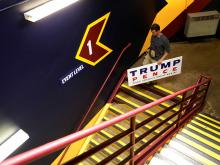
Donald Trump takes pride in rattling the GOP establishment, but he faces a major roadblock on the way to the White House.
Catholic voters, who have been key to picking the winning ticket in almost every modern election, reject Trump decisively. In 2012, President Obama won the overall Catholic vote 50 percent to 48 percent. Hillary Clinton now leads 56 percent to 39 percent, a sizable gap unlikely to close much by November.
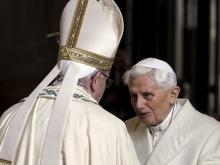
A Vatican ceremony June 28 featuring a rare joint appearance by Pope Francis and his predecessor seemed aimed at tamping down speculation about the unusual circumstance of having two living popes.
In recent weeks debate has erupted over whether there are two popes sharing authority in the church, or whether Francis is the sole successor of St. Peter.
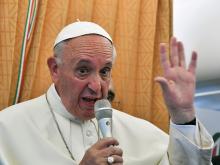
While Francis’ comments on the plane were not officially sanctioned by the Catholic Church, they are another indication that the new boss ain’t the same as the old boss.
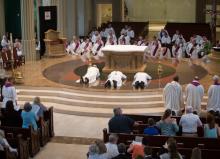
A single chime rang out after each abuse victim’s statement was read over the speakers at the Cathedral of the Immaculate Conception in downtown Kansas City, a solemn echo to enduring pain.
It was a simple, symbolic gesture but one that had an almost inexpressible resonance for those who had been abused, and for many Catholics in a diocese so identified with clergy abuse that its last bishop was forced to resign.

Stop being judgmental hypocrites and take a look at yourself in the mirror — without covering up your wrinkles — Pope Francis advised Catholics in a sermon that reprised one of his favorite themes.
In his last homily at morning Mass before taking a break for the summer, Francis on June 20 said those who constantly judge people should instead reflect on their own behavior.
Will ‘Pope Lenny’ be a hit drama? Or a hilarious disappointment?
Watch the first trailer for the ballyhooed new series, The Young Pope, and your reaction will likely be one or the other.
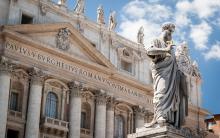
After Native American delegates met with Pope Francis and other Vatican representatives requesting an end to the Doctrine of Discovery, the Vatican said that it would consider rescinding the 500-year-old Catholic policy, reports APTN.
The Doctrine of Discovery is the name for a body of Catholic law that granted land rights to whichever European Christian nation settled territory in the New World. It considered as terra nullius (“nobody’s land”) any territory occupied by “heathens, pagans, and infidels” — in other words, the original inhabitants of the Americas.
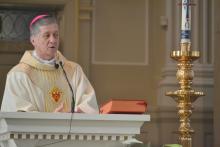
Chicago Archbishop Blase Cupich has decried the apparent targeting of gays and lesbians in the Orlando nightclub massacre and called for greater efforts on gun control, the first senior U.S. Catholic churchman to identify a likely reason the victims were singled out and raise the controversial issue of access to weapons.
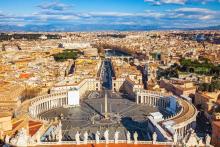
The Vatican has signed a new deal with international accountants, weeks after the unprecedented audit of the Holy See’s finances came to an abrupt halt.
PricewaterhouseCoopers will advise the city-state’s auditor general, the Vatican said on June 10.